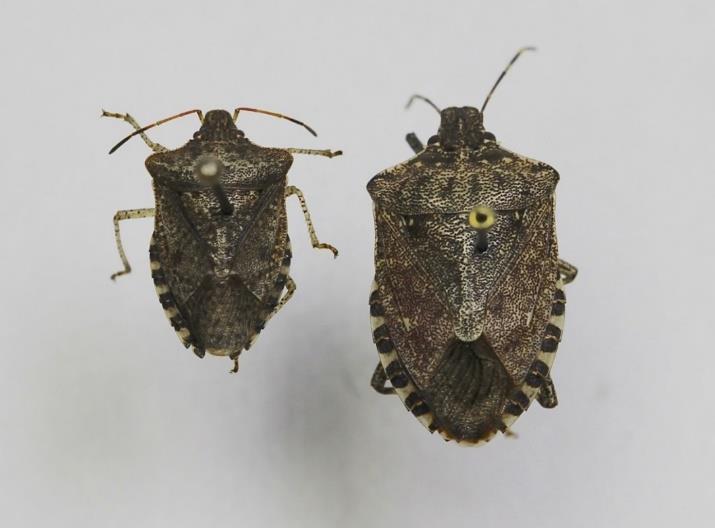Brown Marmorated Stink Bug Look-alike

The brown marmorated stink bug (BMSB) monitoring project is underway and, as of June 8th, we have not caught any BMSB in the pheromone traps. The traps are deployed at 12 locations in counties that were confirmed for the presence of BMSB in recent years. Traps are checked weekly and we will keep you informed of any detection in traps, particularly in apple orchards.
About 10 days ago, we had a suspected specimen that got us a little puzzled from the picture we received. The stink bug in question (left on the photo below) looks very similar to BMSB (right on the photo) with a similar checkered pattern along the abdomen and similar tan color. Once we received the specimen, PJ Liesch, the UW-Madison insect diagnostician (aka the Bug Guy!) was able to identify this specimen to dusky stink bug, Euschistus tristigmus luridis.
Several features can help separate dusky stink bug from BMSB. The main characteristic is the size, hence the need in this case to see the specimen in person as opposed to a picture (a reference such as a ruler or a coin could help determine that in a picture). The dusky stink bug specimen is smaller (less than 1∕2-inch long) compared to BMSB (more than 3⁄5-inch long). The second characteristic is the antennal banding: the antennae on the dusky stink bug do show some colored bands, but these are a reddish in color contrasted with black. On BMSB, the bands are much more discrete and whitish. For more info on BMSB look-alike insects, check out this link http://www.stopbmsb.org/stink-bug-basics/look-alike-insects/
Dusky stink bug can be found in most fruit-growing regions in Eastern North America. It can cause fruit damage in all tree fruit, especially peaches and apples. Adult feeding during bloom can cause the fruit to abort. Feeding later in the summer can lead to deep cat-facing injury or depressed, corky or water-soaked areas on the skin of the fruit. For management, removing broadleaf weeds that are alternate hosts, especially legumes, can help lower populations. If insecticides are needed they should be applied when adults are immigrating in the orchards. From the lack of information available on dusky stink bug, it seems unlikely to be major pest of apple in Wisconsin. If you suspect damage from dusky stink bug, please let us know at guedot@wisc.edu.
Happy Growing Season!
This article was posted in Insects and tagged Brown Marmorated Stink Bug, Christelle Guédot, insects.
